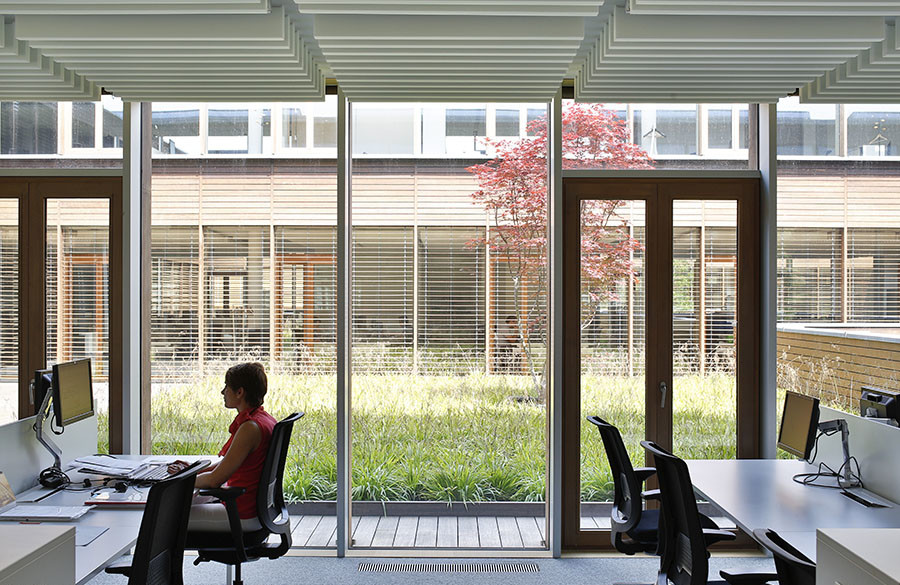Low-iron glass and low-e coatings combine to bring architects and designers another tool in the effort to balance appearance, daylight and energy efficiency.
Interior spaces which prioritize environmental and human wellbeing focus on maximizing daylighting. The benefits to this approach include improved concentration and focus, while reducing the need for artificial illumination. Exposure to natural light can also improve sleep from experiencing situations that mimic the body’s natural circadian rhythms. Unfortunately, depending on the application, increasing daylight may come at a cost; the additional solar energy coming from the visible light spectrum can lead to increased heat.
For some, it can be something of a conundrum to balance the need for copious light with the need for interior temperature regulation. Current glass technology, however, has seen the introduction and advancement of tools which allow architects to strike the right balance between light transmission and thermal gain. AGC’s newest glass products fulfil these technical requirements while also enhancing a building’s aesthetics.
Many modern glass products come equipped with low-e coatings. ‘Low-e’ stands for low emissivity, which is a measurement of a surface’s ability to re-radiate energy. When combined with window shades or blinds, both elements form a comprehensive strategy for managing thermal gain.
Low-e coatings, made from silver and other metals, determine which wavelengths of energy are transmitted, reflected, or are absorbed by the glass. “As we add more layers of silver to a coating,” says Jon Hughes, product manager at AGC, “we increase the selectivity of the ‘low-e’ which means we have the ability to allow more visible light than solar heat gain to enter the building.”

A new low-iron glass substrate from AGC, called PureVision makes this kind of performance available in an aesthetically-pleasing package. Reducing the iron level in these glass products reduces the green tint of the glass, creating a more crystalline, almost colorless product ideal for architects and designers seeking a neutral tone from their glass. Because it allows more light to pass through, PureVision low-iron glass is particularly well suited to higher solar gain applications, like residential windows, where thermal gain can be a positive in mitigating the need for heating, and in the lighting industry where light transmission is all important, says Hughes.
These new substrates are an especially important development for AGC, as other ‘low-e’ coatings in their portfolio have a naturally gray or blue tint, resulting in a neutral tone which can be improved with a low iron substrate like PureVision.
Low iron glass allows more energy to pass through the window, meaning less energy is absorbed by the glass substrate itself, Hughes tells Metropolis. But when it is combined with AGC’s low-e coatings, the energy difference is comparable to traditional low-e glass products that absorb more of the sun’s energy. “The total energy difference, depending on the type of coating you use, may not be significant,” he said, “but the quality is better. You’re getting less color and more light.”
An innovative way to control visible light and solar gain, is available via technology like Halio. Halio, a fully adjustable smart tinting glass product that users can tint on demand, is also available with low-iron glass, allowing for a super clear view that can be adjusted to block heat and light when needed.

As technology advances, companies like AGC are working to meet current demand and improve offerings to the design community. With these new, exceptionally clear glass products and their ability to work seamlessly with top-performing low-e coatings, AGC aims to ease the delicate balance required when specifying glass for windows. There are myriad additional factors that further determine the relationship between daylight and thermal gain: Glass thickness, glass type, coating type, and the IGU configuration, to name but a few.
“We are expanding our options, so architects, designers, and their clients can make the right choices,” Hughes explains. And ultimately, achieving energy efficiency and optimizing daylighting is a unique balancing act, which comes down to the needs of a particular project, and the climate in which the building is situated. Fortunately, companies like AGC are able to help architects and designers along every step of the way, finding the right glass for the right situation and the right blend of performance and aesthetics.
